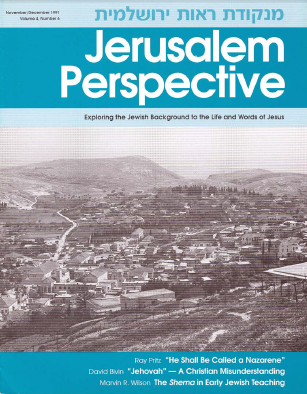Question received from James Shaff (Santa Fe, New Mexico, U.S.A.) that was published in the “Readers’ Perspective” column of Jerusalem Perspective 35 (Nov.-Dec. 1991): 15.
In his article in the Jul.-Aug. 1990 issue, “Sabbath Breakers?” Prof. Shmuel Safrai states that “…the omer [an omer-measure of barley] was offered at the Temple on the 16th of Nisan, the second day of the Passover festival.” The reference Prof. Safrai uses, Leviticus 23:15, which says, “From the day after the Sabbath…,” does not say the day after the Passover Sabbath, which is Nisan 15th. Verse 16 says to count off fifty days up to the day after the seventh Sabbath. This is the weekly Sabbath, or Saturday. Now if you count backwards from this Sabbath you have to come to another weekly Sabbath/Saturday—the Sabbath in verse 15 must be a Saturday, a weekly Sabbath and not the Passover Sabbath. So the Feast of First Fruits is always on a Sunday—the day after the Sabbath—and Shavuot is always on a Sunday. How else can you count off seven weeks up to the day after the seventh Sabbath? For verse 15 says to “count off seven full weeks.” How do you figure the 16th of Nisan as the day of First Fruits?
Shmuel Safrai responds:
Thank you for your question. Your calculations are correct, and both the Sadducees and the Essenes understood the commandment that way. Today’s Samaritans and the Karaites still interpret the commandment in the same way, and they always observe Shavuot on a Sunday. However, the Pharisees, and no doubt Jesus too, understood it differently.
The observance of the holiday of Shavuot, or Pentecost, is a biblical commandment, but unlike other holidays, no specific day or month is prescribed. Consequently, the date of Shavuot was the focus of one of the fiercest of many debates between the Pharisees and Sadducees. The controversy revolved around the interpretation of Leviticus 23:15-16: “From the day on which you bring the sheaf of wave offering—the day after the sabbath—you shall count unto you seven sabbaths. There must be seven complete sabbaths. Up to the day after the seventh sabbath count fifty days, and then present an offering of new grain to the LORD.”
The difference of opinion concerns the meaning of שַׁבָּת (shabat, sabbath) in this passage. Does sabbath here mean Saturday, or sabbath as a day of rest? Both meanings are possible in Hebrew. The Sadducees understood shabat literally as Saturday; therefore “the day after the sabbath,” the first day of the counting of the omer, obviously would always be a Sunday. According to their calendar, then, Shavuot would always fall on the seventh Sunday after Passover. However, the Pharisees interpreted shabat in this passage as “the day of rest” of the holiday, the first day of Passover, a day on which work was forbidden. According to them, the omer would be offered on the sixteenth of the month of Nisan, the second day of Passover, and Shavuot would fall on the sixth of the month of Sivan. It is worth pointing out that already in the second century B.C.E. the Jewish translators of the Septuagint rendered “the day after the sabbath” in Leviticus 23:11 as “the day after the first day [of the festival].”
The dating of the omer offering was very consequential for Temple worship. Its date determined the date of Shavuot when the first fruits of the wheat harvest were offered to the LORD. Because the omer was brought to the Temple and offered there, its date determined the order of the Temple service.
The issue was finally resolved in favor of the Pharisees, and until today orthodox Jews begin counting the omer on the second day of Passover. The general population, who supported the Pharisees and hated the Sadducees, considered this such an important victory that it was celebrated for eight days (Megillat Ta’anit 2). In other areas of daily life the rulings of the Pharisees also were practiced, and although there were bitter controversies, eventually the Pharisaic halachah prevailed even in the major areas of Temple worship. Josephus states that “all prayers and sacred rites of divine worship are performed according to their [the Pharisees’] exposition” (Antiquities 18:15), and that the Sadducees “submit to the formulas of the Pharisees, since otherwise the masses would not tolerate them” (Antiquities 18:17).



![Shmuel Safrai [1919-2003]](https://www.jerusalemperspective.com/wp-content/uploads/userphoto/20.jpg)





























































































Comments 3
MR SAFRAI,
IT IS AN INTERESTING HYPOTHOSIS – WHEN DID THIS CONTROVERSEY BEGIN ? ACCORDING TO MUCH OF THE TEACHINGS OF JESUS HE POINTED OUT MANY PHARISITICAL MISUNDERSTANDINGS OF THE LAW AND THE PROPHETS, BRINGING CLARITY FROM THEIR DILUSIONAL INTERPERTATIONS OF THE LAW (PLACING A YOLK UPON THE BACKS OF THE PEOPLE) ALLUDING IN SOME CASES THEY HAVE MISSED THE VERY INTENT OF THE LAW. I DON’T BELIEVE THEY INTERPERTED LEV 23 THE SAME WAY DURING THE TIME OF THE FIRST TEMPLE. IT WOULD SEEM THE KARAITES AND THE SAMARITANS HAVE THIS ONE CORRECT. THE PHARISITICAL INTERPERTATION IN THE ORAL LAW DOES NOT SHOW UP UNTIL THE TIME OF CHRIST AND THE DESTRUCTION OF THE SECOND TEMPLE. COULD THIS HAVE BEEN AN ATTEMPT TO MALIGN THE VERY FACT THAT JESUS FULFILLED THE LAW TO THE VERY DAY, THIS TESTIMONY HAVING A VERY PROFOUND EFFECT ON THE JEWS LIVING IN THAT PERIOD. THERFORE PLACING A CLOUD OF DOUBT ON THE VERY TIMELINE THAT PUNCTUATED THE FULFILMENT OF THE MESSIAH.
SINCERELY
GENE
Dear Gene,
Unfortunately Professor Safrai, who died in 2003, is unable to respond to your comment. I cannot speak for Professor Safrai, but I can recommend a few articles on Jerusalem Perspective that discuss Jesus’ approach to Torah interpretation. Some of the terminology Jesus used (e.g., Kingdom of Heaven), and many of the techniques Jesus employed for interpreting the Torah, such as kal vahomer (argument by analogy from the lesser to the greater; cf., e.g., Matt. 7:11), gezerah shavah (linking of verses on the basis of identical vocabulary; cf., e.g., Luke 10:27), and the use of parables, were also utilized in the Pharisaic-rabbinic tradition but not in other strains of ancient Judaism such as those represented by the Sadducees and Essenes.
On the term Kingdom of Heaven, I recommend Robert Lindsey’s article, “The Kingdom of God: God’s Power Among Believers,” which includes an important sidebar by Professor Safrai.
On Jesus’ use of gezerah shavah I recommend Joseph Frankovic’s “Remember Shiloh!” and Steven Notley’s “First-century Jewish Use of Scripture: Evidence from the Life of Jesus.”
On Jesus’ exegetical techniques in the Sermon on the Mount, see David Flusser, “‘It Is Said to the Elders’: On the Interpretation of the So-called Antitheses in the Sermon on the Mount”; and on Jesus’ approach to the Oral Torah, I recommend David Bivin’s series, “Jesus and the Oral Torah.”
I hope these recommendations help. Enjoy your studies,
Joshua N. Tilton, editor
JerusalemPerspective.com
Thank you for your response it looks like it will be very helpful. As I get familiar with this site I’m realizing there are some teachings that may render slightly different opinions based on the research of the writer.
Gene